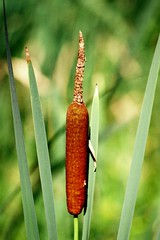
Playa_pixie, over at Flickr, whose home state I rather mercilessly dumped on in a couple of earlier posts, somehow or other got me to admit that I have, in fact, on one occasion eaten parts of that plant up there - the bullrush. Well, not that particular one, but you get the idea.
And the obvious question, of course, is: why?
Well, the answer lies in an endearingly geeky part of my youth when I was a dues-paying member of the Kingston Junior Field Naturalists. A group with meetings where we would learn about identifying birds, examine museum specimens and, on one memorable occasion, even skin small rodents. I was rather proud of the vole skin I produced, stinking of borax though it was. And I only nicked the bowel once with the scalpel, which was, truth be told, probably better than average. Let me tell you this - vole excrement smells like, well, crap.*
On a couple of other occasions, we had field trips to the Prince Edward Point Bird Observatory, overnight trips in the freezing cold where we patrolled the mist nets at regular intervals, plucking out Northern Saw-Whet Owls who'd gotten stuck in them while happily migrating along minding their own business. Cute little fellows, glaring stonily at us while they were subjected to a variety of indignities: being weighed, measured and having bands attached to their legs. They also have sharp talons, believe me. And we only hit one skunk with the car, another memorable experience that I strongly suggest you avoid at all costs.
But - the bullrush.
One of our KFN "activities" was a picnic, where each of us was supposed to bring food that was "found in nature". Thank goodness nobody brought bugs, but the rest of the fare was a bit suspect, there being not a whole lot of fruit and nut trees in that part of Southern Ontario at the best of times. I suspect that small, hard, bitter apples probably played a part, but I confess I don't really remember a whole lot about it.
What I do remember, though, is learning that you can grind up the tubers of the bullrush and make flour out of them. You can also eat the pith out of the stems, and maybe even the fuzzy part at the top if you're brave. Playa_pixie says these remind her of Corn Dogs, but I'm not convinced.
What I do know is that wading around in a muddy swamp, with Red-Winged Blackbirds dive-bombing your head, in search of tiny little roots that when ground up and baked in scones end up tasting, like, well, perfectly ordinary scones with bits of fibrous crud in them that gets stuck between your teeth, is not perhaps the best way to spend any part of a summer afternoon.** But I did it nonetheless, contributed my effort to the picnic, and as a result, 25 years later, you've all learned something about bullrushes and me that you didn't know before.
See? It's all about education here at the Ricardiblog. Really.
*I'm going to have to pay Scaryduck royalties for this one, you know I will.
** We may have a new contender for Longest Sentence On The Ricardiblog™
5 comments:
Oh, yummy. Gak.
Scaryduck only owns the royalties to 'poo.' You can say 'crap' as often as you wish, royalty-free.
100% FACT
foudxub - the Latin name for flour made from bullrushes
Down here, we call those cattails, and I have read stories of the pioneers and such making bread out of them. The spikes do look like corndogs, but the taste is rather different, I would guess...
Debi - it might be that cattail is more common up here, but my English heritage forces me to call them bullrushes. Or bulrushes. I'm too lazy to figure out which is correct...
See? This is what English heritage does to a person--forces them to do things that they might not otherwise do...
:)
iwloq: the Inuit word for bulrushes...
Post a Comment